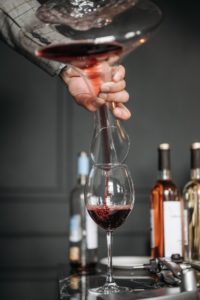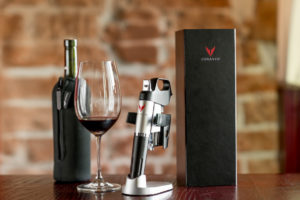How to keep that open bottle on life support: Tending to the Wine Wounded Soldiers
Although we do our best to “finish what’s on our plate”, so to speak, there are occasions where we are just not able to empty that bottle. It’s a sad story really. Maybe we had good intentions to fulfill the purpose that these grapes gave their life for, but in our intoxicated hopefulness, we fell short of our expectations. Fret not, this story, potentially, has a happy ending if you heed some sound advice. I will do my best to ensure that these wines do not go quietly in that good night.
First, you need a basic understanding (because this stuff can be complicated), of why your wine will perish if left unchecked, without intervention, over a course of several hours, or overnight. This wine killer has a name that you may be familiar with, oxidation. This is the same serial killer that targets all fruit, and most foods stuff, robbing them of their tastefulness and replacing it with off-odors and flavors.
Much like myself with my parents, wine and oxygen often times have a complicated relationship. There are times in the production process that some oxygen exposure is quite beneficial but other times it can result in an unsalvageable fault. The amount, duration of exposure, and when in the wine making process the wine is exposed also plays into the equation with a usually “a little goes a long way” type of attitude. How oxygen plays into the process of winemaking can be found here.
Once you have your bottled treasure home and you’ve popped the cork, something happens. The wine no longer enjoys that protected environment inside the bottle. It is now exposed to the harsh and cruel outside world, one with oxygen and thus potential oxidation. Not all oxygen exposure, however, renders a death sentence to our wines. Sometimes the introduction of wine to oxygen is quite purposeful and improves the “drinkability” of said wine.
Aeration remains one of the times that we want the wine to get some oxygen contact, resulting in some potential advantageous changes. When the wine is “splashed” into the decanter, with the wide bottom, (a joke that takes me great restraint to not comment on), the wine has exposure to oxygen. This helps to “blow off” some reductive compounds that can make a wine seem muted of aromatics or even a bit stinky. The chemistry behind these reduced sulfur compounds is extremely complex and I think Jamie Goode does one of the best jobs in explaining this in relatively simple terms. The good aromatics in wine can also benefit from a bit of exposure to volatize, come out of the wine, and reach our retronasal passages and finally to the brain.
The other element that makes the wine more approachable has to do with tannins. Tannin chemistry during winemaking and in the bottle is not completely understood. We know enough to tell us that oxygen can help these “soften” and make the wine feel less astringent (mouth-drying). So, decanting (aerating) certain wines make them more “approachable” (or drinkable without a water chaser); what I would call a good thing. The tricky part is that not all wines benefit from a little splashing and oxygen exposure prior to consumption. There are wines that are very delicate and this process will surely push them over the cliff into wine oblivion, never to be enjoyed again.
So, pray tell, how do we know what wine to aerate before we drink and which we should just open and drink. Another complication to my consumption and one that further pushes people away from wine consumption. I understand your frustrations and I will attempt to alleviate your anxieties over this exaggeratedly complex topic. I wish I could give you a list of wines that need aerated, as many other “wine experts” do, but I prefer to be truthful. I can speak in generalizations about these wines because it does somewhat come down to personal taste. I can tell you what I generally do in these cases and you can experiment and derive your own protocol from there.
I tend to aerate younger, higher tannin, sturdy wines (Cabernet Sauvignon, Nebbiolo, Syrah, etc.) due to helping “soften” them and “open them up” with oxygen exposure. The tannin structure seems less astringent and mouth drying and the volatile aromatics seem to come out of the wine for my appreciation and enjoyment with some exposure time. I’m pragmatic with many wine and spirit dogma. For this reason, I find myself pouring a small pour (just a few ounces) and sip the wine. Then I swirl the wine in the glass and taste again. If the wine seems “closed” or the aromas and flavors are somewhat muted, then I give it some time in the fat-bottomed decanter (as it makes the wine world go round). If a few brief swirls bring the wine to life or it’s drinkable with my sample sip, I tend to restrain myself from trying to make it better.
As another generalization, older and lighter low tannin wines (Pinot Noir, Gamay, etc.) usually do not need a lot of time with oxygen ex posure. Sometimes attempting to aerate these lighter, more fragile wines or those “longer in the tooth” (aged a long time) can push them over the edge. If you listen close to the wine it will tell you, “Don’t wait. Drink me now.” Heed that advice. When alcohol speaks to you, it usually knows what it’s talking about.
posure. Sometimes attempting to aerate these lighter, more fragile wines or those “longer in the tooth” (aged a long time) can push them over the edge. If you listen close to the wine it will tell you, “Don’t wait. Drink me now.” Heed that advice. When alcohol speaks to you, it usually knows what it’s talking about.
Yes, some white wines can benefit with a little aeration but I usually get them to open enough with a gentle swirl in the glass rather than using an aerator. I find that some white wines have a little reductive “funk” that renders itself as an unpleasant first whiff. These wines can sit in the glass for a few minutes and will usually “unfunkify” with more swirling. If it doesn’t get better, then we start thinking wine faults, which is a topic for another discussion.
Since we talked about aeration on that long but well-worded digression, I feel obliged to at least touch on decanting. This often-misused word really refers to pouring from one vessel (the bottle), into another vessel (a decanter) for the purposes of aeration, separating the wine from the sediment in the bottle, or both. Not all decanters are aerators. Now that you have a little more understanding about aeration, decanting, oxidation, etc., we can discuss how to keep your wine from suffering a quick and painful (to your pocketbook) demise. In the unlikely event you do not finish that bottle there are a few considerations to think about.
The first thing to consider is when you plan on returning to the wine and how much is left in the bottle. If you plan on returning to finish it off within a few days then I recommend the Vacu Vin wine saver and store in the fridge. The wine saver pulls a vacuum and the cooler temps will slow the oxidation process. You can experiment but I’ve been successful with drinking wines a week later using this method. One caveat is the bottle should be close to half full or more. If there are only a few ounces left in the bottle, it will not survive as long, if at all; much for the same reason I give little clout to political speeches, too much headspace.
 If you want to put it to rest for a little longer, then you can displace the oxygen in the bottle with a spray gas like Private Preserve. This will blanket the wine and give you a number of weeks of life especially if you, again, cool the bottle by shelfing it in the fridge. If you want to take just a glass out of a bottle and lay the wine back down for months or longer than there is one solution that remains one of the best in the industry, Coravin. There are many types available but these are worth the cost, especially if you are tasting those expensive bottles to determine if they have hit that aging sweet spot.
If you want to put it to rest for a little longer, then you can displace the oxygen in the bottle with a spray gas like Private Preserve. This will blanket the wine and give you a number of weeks of life especially if you, again, cool the bottle by shelfing it in the fridge. If you want to take just a glass out of a bottle and lay the wine back down for months or longer than there is one solution that remains one of the best in the industry, Coravin. There are many types available but these are worth the cost, especially if you are tasting those expensive bottles to determine if they have hit that aging sweet spot.
Wasting wine is borderline sacrilegious so take the advice that applies to your situation. Even though I am a judger (ENFJ), I will refrain in this instance. We have all made the mistake of opening a bottle when we were already overserved, or tired only to be encumbered with the responsibility of that half-filled bottle. As long as you save that wine for another day, you avoid that potential party foul and shameful wastage. There are starving people in third world countries… you know the rest; we all had a childhood.




